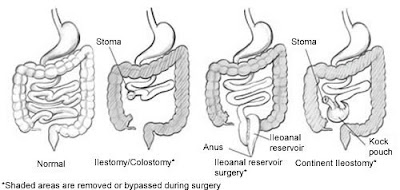There are several types of bowel diversion surgery wherein it can allow passage of stool out of the body when a portion of the large intestine is removed or needs time to heal. The term "bowel" is a general term for any part of the small or large intestine.
An "ostomy surgery" diverts the bowel to an opening made on your abdomen wherein a stoma (see illustration below) is made. This procedure is done in some of the bowel diversion surgeries. A stoma is formed by your surgeon by rolling the end of the bowel back on itself then stitches it on your abdominal abdomen. The stool that comes out of the stoma are collected in an ostomy pouch that is worn outside the body.
In other bowel diversion surgeries, the intestine is reconfigured after the damaged part or parts are removed. For instance, after the colon has been removed, your surgeon will create a colonlike pouch out of the last part of the small intestine. Here, an ostomy pouch is not necessary.
The following are the different types of bowel diversion surgery.
Depending on your condition, your doctor may recommend a specific surgical procedure that is catered to your needs and depends on your condition. He or she will discuss with you the details of the procedure and what you're going to expect from it.
Source: National Digestive Diseases Information Clearinghouse. "Bowel Diversion Surgeries: Ileostomy, Colostomy, Ileoanal Reservoir, and Continent Ileostomy" Available from http://digestive.niddk.nih.gov/ddiseases/pubs/ileostomy/index.htm. Accessed on September 29, 2010.
[Top of Page]
An "ostomy surgery" diverts the bowel to an opening made on your abdomen wherein a stoma (see illustration below) is made. This procedure is done in some of the bowel diversion surgeries. A stoma is formed by your surgeon by rolling the end of the bowel back on itself then stitches it on your abdominal abdomen. The stool that comes out of the stoma are collected in an ostomy pouch that is worn outside the body.
 |
| An illustration of a stoma |
In other bowel diversion surgeries, the intestine is reconfigured after the damaged part or parts are removed. For instance, after the colon has been removed, your surgeon will create a colonlike pouch out of the last part of the small intestine. Here, an ostomy pouch is not necessary.
The following are the different types of bowel diversion surgery.
Depending on your condition, your doctor may recommend a specific surgical procedure that is catered to your needs and depends on your condition. He or she will discuss with you the details of the procedure and what you're going to expect from it.
Ileostomy. In this procedure, the ileum - the last part of the small intestine - is diverted to a stoma. This then bypasses the large intestine and semisolid wastes flow out of the stoma, which is collected in an ostomy pouch. According to the National Digestive Diseases Information Clearinghouse, this procedure has the fewest complications.
Colostomy. This is similar to an ileostomy, however, the colon is diverted to the stoma and not the ileum. Stool is also collected in an ostomy pouch.
Ileoanal reservoir surgery. This procedure is done when the large intestine is removed but the anus, which is disease-free, is left intact. The surgeon creates an ileoanal reservoir, which is a colonlike pouch created from the last few inches of the ileum. The reservoir is also called a pelvic pouch or J-pouch. Stool collected in the ileoanal reservoir passes out of the body during a bowel movement through the anus.
People who have undergone this procedure may initially have about 6 to 10 bowel movements per day but may decrease to as few as 4 to 6 a day once the new reservoir has adjusted to its new function. Usually, a temporary ileostomy may be done where stool can pass through a stoma that is collected in an ostomy pouch. This is done to allow healing of the ileoanal reservoir surgery.
Continent ileostomy. This surgical procedure may be an option for people who don't want to wear an ostomy pouch but are not good candidates for ileoanal reservoir because their rectum or anus is damaged. Like in ileoanal reservoir surgery, the large intestine is removed and a pouch is made from the end of the ileum, which is connected to a stoma. The colon-like pouch is called Kock pouch.
People who have undergone this procedure do not need to wear an ostomy pouch to collect stool. However, the Kock pouch must be drained each day. To drain the pouch, a tube is inserted through the stoma to allow passage of stool.
 |
| Types of Bowel Diversion Surgery |
Source: National Digestive Diseases Information Clearinghouse. "Bowel Diversion Surgeries: Ileostomy, Colostomy, Ileoanal Reservoir, and Continent Ileostomy" Available from http://digestive.niddk.nih.gov/ddiseases/pubs/ileostomy/index.htm. Accessed on September 29, 2010.
[Top of Page]
